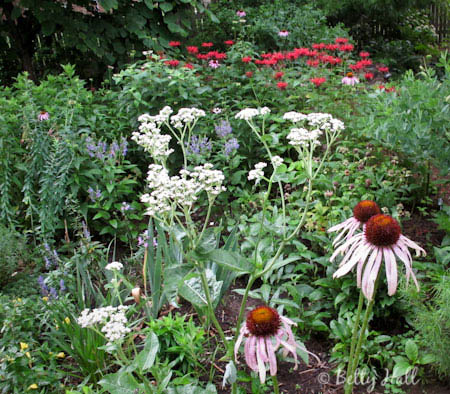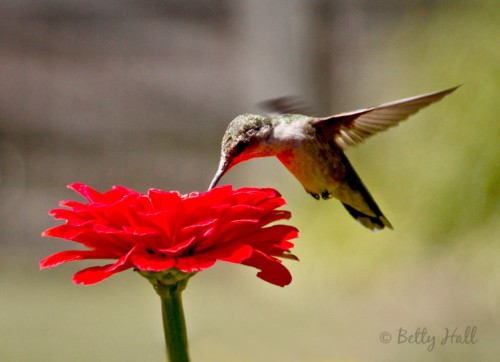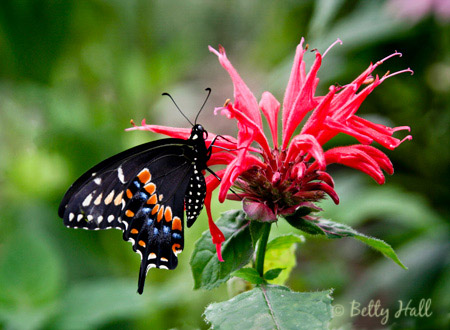We’re almost to the end of 2011 and I’m feeling reflective. The backyard continues to be a great source of enjoyment. This Ruby-throated Hummingbird (Archilochus colubris) and zinnia image captures one of many magical moments I’ve experienced.
Category: Summer
Tropical Milkweed
Oh, happy day! Early last Thursday morning I checked the garden and was thrilled to discover a beautiful Monarch caterpillar (Danaus plexippus) on my annual Tropical Milkweed (Asclepias curassavica).

This is the first time I’ve grown Tropical Milkweed, also known as Bloodflower, and I’m delighted to know the Monarchs like it. It’s a tall slender plant and has been easy to fit among my other garden plants. It also has a beautiful blossom.

I’ve checked the North American Butterfly Association website and the more I read about this plant the more I’m impressed. It’s not native to the U.S. but is grown in a wide range, does not seem invasive, and attracts Monarchs. Sounds good to me. If you’ve grown Tropical Milkweed, I’d be glad to know your experience.
P.S. I realize this is short notice but I’ll be doing a presentation on Raising and Attracting Butterflies, at the Lexington Arboretum on Tuesday, July 19th, 10 a.m.- noon. I’d be glad to have you join us.
Update/Caution: I had a scary experience after cutting Tropical Milkweed for some Monarch caterpillars. Apparently I got some of the sap in my eyes, and by the next morning I could barely see. Read the full saga. If you are working with any milkweed plants, be careful to keep the sap away from your eyes and wash your hands thoroughly when you’re done.
Butterflies and watermelon
I’m not seeing as many butterflies this year, so I decided to put out some watermelon to see what it would attract. Sure enough, I had three different visitors.
If you look closely at the small white markings on the underside of the wings of this Question Mark butterfly (Polygonia interrogationis), you can see where it gets its name. You may need to use your imagination! I’ve never seen this butterfly nectaring on flowers, but I have attracted it with over-ripe fruit before.
Seeing this Tawny Emperor (Asterocampa clyton) was a special treat. I saw one in the backyard for the first time last year, and this is the first I’ve seen this year.
The silhouette of the American Snout (Libytheana carinenta) makes it easy to identify, and makes its name rather obvious. What looks like a “snout” is actually elongated mouth parts (or “palps”).
The caterpillars of all three butterflies feed on Hackberry trees (Celtis occidentalis). We don’t have any Hackberries in our yard, so I’m glad our neighbors do.
I’ve heard other people say they have seen fewer butterflies than usual around Lexington this year. I’m curious what you’re seeing.
Garden tour and Scarlet Bee Balm
I’m happy to say the Wild Ones 2011 Kentucky Native Plant Tour went quite well. We had ominous weather reports the night before, but Sunday afternoon turned out to be a great time to be outdoors. We had approximately 200 participants.
It’s quite gratifying to know so many people have an interest in native plants. It was also a great opportunity to let folks know about our local chapter of Wild Ones. This organization is a valuable resource for those wanting to know about using natives in their landscapes.
The showiest plant in my backyard this weekend was the Scarlet Bee Balm (Monarda didyma) which is now at peak bloom. This is a sentimental plant for me as I remember it from my grandmother’s garden. I love to crush and smell its aromatic leaves. I also like to use it in bouquets.
Someone on the tour asked if butterflies used Bee Balm. I have recently seen Pipevine Swallowtails (Battus philenor) and Ruby-throated Hummingbirds (Archilochus colubris) on it. Here is a Black Swallowtail (Papilio polyxenes) visiting a Bee Balm blossom.
I enjoy sharing our backyard. If you were unable to attend the tour would like to see it, please let me know and we’ll arrange a time.
There were so many tour participants that I ran out of copies of the history of our garden and resource list. Click the previous link to download a pdf.
Plans are underway for another Kentucky Native Plant Garden Tour next year – showcasing three different gardens. If you have any ideas or feedback, I’d like very much to receive them. You can leave a comment on this blog, which will be visible to the public, or send me a private message.
Summer solstice flowers
As the summer solstice arrives, I’m seeing more flowers in the backyard. I’ve been unsure what would be blooming for the Wild Ones Kentucky native plant garden tour this weekend. It now appears there will be a nice variety. Here is the color in one corner of the garden.
 The Pale Purple Coneflowers (Echinacea pallida) and the white Wild Quinine (Parthenium integrifolium) in the foreground have been blooming for three weeks and will not last much longer. The purplish blooms behind the Quinine are Downy Skullcap (Scutellaria incana) which add nice contrast. In the background, the red Bee Balm (Monarda fistulosa) is at its peak and the Purple Coneflowers (Echinacea purpurea) are beginning to bloom.
The Pale Purple Coneflowers (Echinacea pallida) and the white Wild Quinine (Parthenium integrifolium) in the foreground have been blooming for three weeks and will not last much longer. The purplish blooms behind the Quinine are Downy Skullcap (Scutellaria incana) which add nice contrast. In the background, the red Bee Balm (Monarda fistulosa) is at its peak and the Purple Coneflowers (Echinacea purpurea) are beginning to bloom.
Other plants now blooming include:
 1. Garden Phlox (Phlox paniculata), 2. Wild Hydrangea (Hydrangea arborescens) 3. Purple Poppy Mallow (Callirhoe involucrata), 4. Royal Catchfly (Silene regia), 5. Purple Milkweed (Asclepias purpurascens), 6. Rattlesnake Master(Erynigium yuccifolium), 7. Button Bush (Cephalanthus occidentalis), 8. Culver’s Root (Veronicastrum virginicum), and 9. Ox-eye Sunflower (Heliopsis helianthoides).
1. Garden Phlox (Phlox paniculata), 2. Wild Hydrangea (Hydrangea arborescens) 3. Purple Poppy Mallow (Callirhoe involucrata), 4. Royal Catchfly (Silene regia), 5. Purple Milkweed (Asclepias purpurascens), 6. Rattlesnake Master(Erynigium yuccifolium), 7. Button Bush (Cephalanthus occidentalis), 8. Culver’s Root (Veronicastrum virginicum), and 9. Ox-eye Sunflower (Heliopsis helianthoides).
I’m delighted to see the mid-summer blooms and the various insects they attract. And I’m looking forward to sharing the backyard as part of the garden tour. If you are in the area, I hope to see you!






